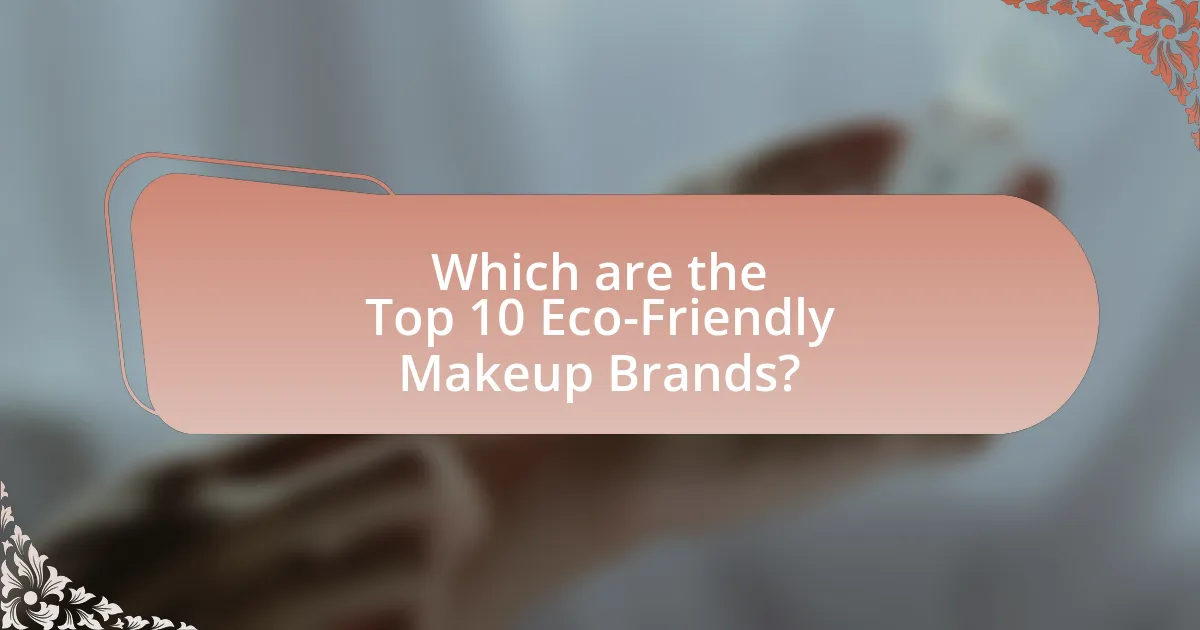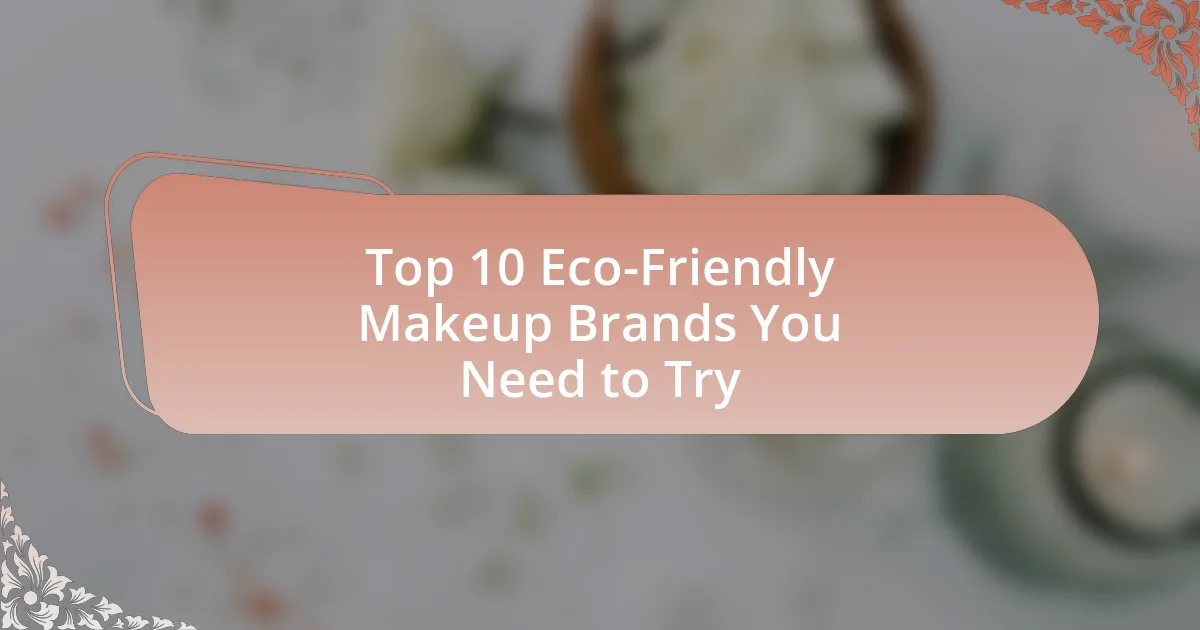Eco-friendly makeup brands are companies that prioritize sustainable practices and ingredients, focusing on natural, organic, and cruelty-free formulations. This article highlights the importance of choosing eco-friendly makeup to minimize environmental impact and promote sustainability, while also addressing the harmful effects of traditional cosmetics. It outlines the criteria that define eco-friendly brands, the ingredients to avoid, and the packaging choices that enhance sustainability. Additionally, the article presents the top 10 eco-friendly makeup brands, detailing their unique features and commitment to ethical practices, as well as the broader impacts of supporting these brands on the beauty industry and the environment.

What are Eco-Friendly Makeup Brands?
Eco-friendly makeup brands are companies that produce cosmetics using sustainable practices and ingredients that are less harmful to the environment. These brands often prioritize natural, organic, and cruelty-free ingredients, minimizing their ecological footprint through responsible sourcing, packaging, and production methods. For example, brands like RMS Beauty and Ilia Beauty utilize recyclable packaging and avoid harmful chemicals, aligning with eco-conscious consumer values.
Why is it important to choose eco-friendly makeup?
Choosing eco-friendly makeup is important because it minimizes environmental impact and promotes sustainability. Eco-friendly makeup products are often made from natural ingredients that reduce pollution and waste, unlike conventional cosmetics that may contain harmful chemicals and contribute to environmental degradation. For instance, a study published in the journal “Environmental Science & Technology” found that certain chemicals in traditional makeup can harm aquatic ecosystems when washed off. By opting for eco-friendly options, consumers support brands that prioritize ethical sourcing, cruelty-free practices, and biodegradable packaging, thereby fostering a healthier planet and encouraging responsible consumer behavior.
What environmental impacts does traditional makeup have?
Traditional makeup has significant environmental impacts, primarily due to the use of synthetic chemicals, plastic packaging, and animal testing. The production of traditional cosmetics often involves harmful ingredients like parabens and phthalates, which can contaminate water sources and harm aquatic life. Additionally, the cosmetics industry generates substantial plastic waste; in 2020, it was estimated that over 120 billion units of packaging were produced, much of which is not recyclable. Furthermore, animal testing practices contribute to biodiversity loss and ethical concerns regarding animal welfare. These factors collectively highlight the detrimental effects of traditional makeup on the environment.
How do eco-friendly brands mitigate these impacts?
Eco-friendly brands mitigate environmental impacts by utilizing sustainable materials, reducing waste, and implementing ethical sourcing practices. For instance, many eco-friendly makeup brands use biodegradable packaging and natural ingredients, which minimize pollution and reduce the carbon footprint associated with production. Additionally, brands like RMS Beauty and Ilia Beauty prioritize cruelty-free testing and support fair trade practices, ensuring that their supply chains are responsible and socially conscious. This approach not only lessens environmental harm but also promotes a more sustainable industry overall.
What criteria define an eco-friendly makeup brand?
An eco-friendly makeup brand is defined by its commitment to sustainable practices, including the use of natural, non-toxic ingredients, environmentally responsible packaging, and cruelty-free testing methods. These brands prioritize formulations that avoid harmful chemicals, such as parabens and sulfates, which can be detrimental to both health and the environment. Additionally, eco-friendly brands often utilize recyclable or biodegradable packaging to minimize waste and reduce their carbon footprint. For instance, a study by the Environmental Working Group highlights that products with fewer synthetic ingredients are generally safer for both consumers and ecosystems.
What ingredients should be avoided in makeup products?
Makeup products should avoid ingredients such as parabens, sulfates, phthalates, synthetic fragrances, and formaldehyde-releasing preservatives. Parabens are known endocrine disruptors, which can interfere with hormone function, while sulfates can strip natural oils from the skin, leading to irritation. Phthalates are linked to reproductive issues, and synthetic fragrances can cause allergic reactions and skin sensitivities. Formaldehyde-releasing preservatives, such as DMDM hydantoin, can pose health risks, including skin irritation and potential carcinogenic effects. These ingredients are often scrutinized for their negative impact on health and the environment, making them undesirable in eco-friendly makeup formulations.
How do packaging choices affect a brand’s eco-friendliness?
Packaging choices significantly impact a brand’s eco-friendliness by determining the materials used, their recyclability, and the overall environmental footprint. Brands that opt for biodegradable, recyclable, or reusable packaging contribute to reduced waste and lower carbon emissions compared to those using single-use plastics. For instance, a study by the Ellen MacArthur Foundation highlights that shifting to sustainable packaging can reduce greenhouse gas emissions by up to 70% in certain industries. Therefore, the selection of eco-friendly packaging materials directly correlates with a brand’s commitment to sustainability and environmental responsibility.

Which are the Top 10 Eco-Friendly Makeup Brands?
The top 10 eco-friendly makeup brands are RMS Beauty, Ilia Beauty, 100% Pure, Bite Beauty, Tarte Cosmetics, Alima Pure, Kjaer Weis, EcoTools, E.l.f. Cosmetics, and Aether Beauty. These brands are recognized for their commitment to sustainability, using natural ingredients, and eco-conscious packaging. For instance, RMS Beauty emphasizes organic ingredients and recyclable packaging, while Ilia Beauty focuses on clean formulations and sustainable sourcing. Each brand has been vetted for its environmental practices and product integrity, making them leaders in the eco-friendly makeup industry.
What makes each of these brands stand out?
Each of the top 10 eco-friendly makeup brands stands out due to their commitment to sustainability, ethical sourcing, and innovative formulations. For instance, brands like RMS Beauty emphasize organic ingredients and minimal processing, ensuring that their products are both effective and environmentally friendly. Similarly, Ilia Beauty focuses on clean, skin-loving ingredients while maintaining a chic aesthetic, appealing to consumers who prioritize both health and style. Additionally, brands such as Bite Beauty utilize food-grade ingredients, highlighting their dedication to safety and sustainability. These unique attributes, combined with transparent practices and eco-conscious packaging, differentiate these brands in a competitive market.
What unique features does Brand A offer?
Brand A offers a unique combination of sustainable sourcing, cruelty-free formulations, and biodegradable packaging. The brand prioritizes eco-friendly ingredients, ensuring that all products are derived from natural sources and free from harmful chemicals. Additionally, Brand A’s commitment to ethical practices is evident in its certification by recognized organizations, which verifies its cruelty-free status. The use of biodegradable packaging further enhances its environmental responsibility, allowing consumers to reduce waste while enjoying high-quality makeup products.
How does Brand B prioritize sustainability?
Brand B prioritizes sustainability by utilizing eco-friendly ingredients and implementing sustainable packaging practices. The brand sources natural and organic materials, ensuring that their products are free from harmful chemicals, which aligns with environmental conservation efforts. Additionally, Brand B employs recyclable and biodegradable packaging, reducing plastic waste and promoting a circular economy. This commitment to sustainability is further evidenced by their partnerships with environmental organizations, which aim to restore ecosystems and support biodiversity.
How do these brands ensure product safety and effectiveness?
These brands ensure product safety and effectiveness through rigorous testing and adherence to regulatory standards. They conduct clinical trials and safety assessments to evaluate the potential risks and benefits of their products, ensuring that ingredients are safe for consumer use. For instance, many eco-friendly makeup brands utilize third-party laboratories to verify the safety of their formulations, which helps in maintaining transparency and trust. Additionally, they often follow guidelines set by organizations such as the Environmental Working Group (EWG) and the FDA, which provide frameworks for safe cosmetic practices. This commitment to safety is further supported by the use of natural and organic ingredients, which are less likely to cause adverse reactions compared to synthetic alternatives.
What testing methods do eco-friendly brands use?
Eco-friendly brands typically use methods such as in-vitro testing, which involves testing on cell cultures rather than animals, and third-party lab testing to ensure product safety and efficacy without harming the environment. These brands often adhere to cruelty-free certifications and utilize natural ingredients that are biodegradable and non-toxic. For instance, the Leaping Bunny certification verifies that no animal testing is conducted at any stage of product development, reinforcing the commitment to ethical practices.
How do these brands maintain product quality while being eco-conscious?
These brands maintain product quality while being eco-conscious by utilizing sustainable sourcing, innovative formulations, and rigorous testing standards. For instance, many eco-friendly makeup brands source ingredients from organic farms, ensuring that the raw materials are free from harmful pesticides and chemicals, which not only supports environmental health but also enhances product safety and efficacy. Additionally, these brands often invest in research and development to create high-performance products that meet consumer expectations without compromising on environmental values. A notable example is the use of biodegradable packaging, which reduces waste while maintaining the integrity of the product. Furthermore, brands frequently conduct thorough quality control processes to ensure that their eco-friendly products meet industry standards, thereby reinforcing their commitment to both quality and sustainability.

What are the benefits of using Eco-Friendly Makeup?
Eco-friendly makeup offers several benefits, including reduced environmental impact, improved skin health, and ethical sourcing. By using natural ingredients and sustainable packaging, eco-friendly makeup minimizes pollution and waste, contributing to a healthier planet. Additionally, many eco-friendly products are free from harmful chemicals, which can lead to fewer skin irritations and allergies. Research indicates that consumers are increasingly prioritizing products that align with their values, with a 2021 survey showing that 70% of consumers prefer brands that are environmentally responsible. This shift not only supports ethical practices but also encourages the beauty industry to adopt more sustainable methods.
How does eco-friendly makeup benefit your skin?
Eco-friendly makeup benefits your skin by using natural ingredients that are less likely to cause irritation or allergic reactions. These products often contain fewer synthetic chemicals, which can lead to healthier skin over time. For instance, many eco-friendly brands utilize organic oils, plant extracts, and minerals that nourish the skin, providing hydration and promoting a balanced complexion. Studies have shown that formulations with natural ingredients can improve skin health by reducing inflammation and enhancing moisture retention, making them suitable for sensitive skin types.
What natural ingredients are commonly found in eco-friendly makeup?
Common natural ingredients found in eco-friendly makeup include plant-based oils, minerals, and botanical extracts. For example, jojoba oil is often used for its moisturizing properties, while mica and titanium dioxide serve as natural pigments and sunscreens. Additionally, ingredients like shea butter and aloe vera are included for their skin-soothing benefits. These components are favored in eco-friendly formulations due to their biodegradable nature and lower environmental impact compared to synthetic alternatives.
How do these ingredients contribute to skin health?
Certain ingredients in eco-friendly makeup brands contribute to skin health by providing nourishment, hydration, and protection. For instance, natural oils like jojoba and argan oil are rich in fatty acids and vitamins, which help to moisturize the skin and improve its barrier function. Additionally, botanical extracts such as aloe vera and green tea are known for their anti-inflammatory and antioxidant properties, which can soothe irritation and protect against environmental damage. Studies have shown that antioxidants can reduce oxidative stress on the skin, leading to a healthier appearance. Therefore, the inclusion of these beneficial ingredients in eco-friendly makeup formulations supports overall skin health effectively.
What are the broader impacts of supporting eco-friendly brands?
Supporting eco-friendly brands leads to significant environmental and social benefits. By choosing these brands, consumers contribute to reduced carbon footprints, as many eco-friendly companies prioritize sustainable sourcing and production methods. For instance, a study by the Global Footprint Network indicates that sustainable practices can lower greenhouse gas emissions by up to 50%. Additionally, supporting these brands fosters ethical labor practices, as many eco-friendly companies emphasize fair wages and safe working conditions. This shift not only promotes environmental sustainability but also encourages a more equitable economy, benefiting communities and ecosystems alike.
How does purchasing eco-friendly makeup influence the beauty industry?
Purchasing eco-friendly makeup significantly influences the beauty industry by driving brands to adopt sustainable practices and reformulate products. As consumer demand for environmentally responsible products increases, companies are compelled to innovate, leading to a rise in the availability of biodegradable packaging and cruelty-free formulations. For instance, a 2021 report by Grand View Research indicated that the global green beauty market is expected to reach $22 billion by 2024, reflecting a growing trend towards sustainability. This shift not only impacts product offerings but also encourages transparency in sourcing and manufacturing processes, ultimately reshaping industry standards and consumer expectations.
What role do consumers play in promoting sustainability?
Consumers play a crucial role in promoting sustainability by driving demand for eco-friendly products and practices. Their purchasing choices influence brands to adopt sustainable practices, such as using biodegradable packaging and ethically sourced ingredients. For instance, a 2021 Nielsen report indicated that 73% of global consumers are willing to change their consumption habits to reduce environmental impact. This consumer behavior encourages companies in the makeup industry to prioritize sustainability, leading to a broader shift towards environmentally responsible practices.
What tips can help you choose the right eco-friendly makeup products?
To choose the right eco-friendly makeup products, prioritize brands that use natural, organic ingredients and sustainable packaging. Research the ingredient list to ensure it is free from harmful chemicals like parabens and sulfates, which can be detrimental to both health and the environment. Look for certifications such as USDA Organic or cruelty-free labels, which indicate adherence to eco-friendly practices. Additionally, consider the brand’s commitment to sustainability, including their sourcing methods and waste reduction initiatives. Studies show that consumers increasingly prefer products with transparent ingredient sourcing, reflecting a growing demand for ethical beauty options.
How can you identify truly eco-friendly brands?
To identify truly eco-friendly brands, examine their certifications, ingredient transparency, and sustainable practices. Brands that hold certifications such as USDA Organic, Fair Trade, or Leaping Bunny demonstrate a commitment to environmentally friendly practices. Additionally, eco-friendly brands typically disclose their ingredient sourcing and production processes, allowing consumers to assess their environmental impact. Research shows that companies with sustainable practices, such as using recyclable packaging or reducing carbon emissions, are more likely to be genuinely eco-friendly. For instance, a study by the Global Reporting Initiative found that companies prioritizing sustainability report better environmental performance.
What should you consider when trying new eco-friendly products?
When trying new eco-friendly products, you should consider their ingredients, sourcing practices, and certifications. Ingredients should be natural, biodegradable, and free from harmful chemicals, as this ensures safety for both users and the environment. Sourcing practices are crucial; products should be made from sustainably harvested materials to minimize ecological impact. Certifications, such as cruelty-free or organic labels, provide assurance of ethical production standards. Research indicates that consumers increasingly prefer products with transparent ingredient lists and verified sustainability claims, reflecting a growing demand for responsible consumerism.


